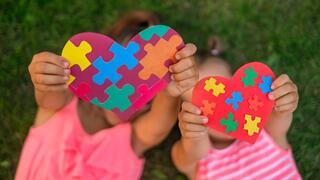The prevalence of autism in Israel is on the rise, with significant increases linked to parental age, according to data from the Central Bureau of Statistics released on Monday ahead of World Autism Awareness Day, which is observed on Wednesday. As of 2023, 68,197 individuals in Israel were officially recognized as being on the autism spectrum, a prevalence rate of seven per 1,000 people. Of those diagnosed, 76% were male, and 82% were children or adolescents under the age of 17.
The data further indicate that 45% of individuals on the spectrum have an additional disability, and 11% have two or more additional disabilities. 2 View gallery As of 2023, 68,197 individuals in Israel were officially recognized as being on the autism spectrum ( Photo: Shutterstock ) Autism prevalence has increased over time, rising from 4.7 per 1,000 among those born in 2000 (23 years old in 2023) to 28.

3 per 1,000 among those born in 2018 (five years old in 2023). The bureau noted that this rise does not necessarily reflect a higher incidence of autism but is likely due to improvements in diagnosis and detection within Israel's health care system. Autism spectrum disorders encompass a range of neurodevelopmental conditions characterized by impairments in communication and social skills, often accompanied by restricted interests and repetitive behaviors.
Israel's diagnostic criteria follow the DSM-5 classification system, which has evolved over time to include more individuals. Gender disparities in diagnosis Males are diagnosed with autism at higher rates than females across all age groups. Among boys aged 4-5, the rate is 39.
1 per 1,000, compared with 13.7 per 1,000 for girls. In older age groups, such as those aged 21-25, the prevalence drops to 7.
4 per 1,000 for men and 2 per 1,000 for women. The rising prevalence of autism is a trend seen worldwide. In the United States, the rate increased from 6.
7 per 1,000 among those born in 2000 to 27.6 per 1,000 among those born in 2020. Parental age is a key factor in autism rates.
Among children born between 2000 and 2012, the prevalence of autism was 20% higher among children of fathers aged 45-46 compared to fathers aged 23-24. Among mothers, the rate was 101% higher (from 10 per 1,000 at age 23-24 to 21 per 1,000 at age 45-46). The trend persists for children born between 2013 and 2018.
Interestingly, among very young parents (under 23), autism rates were higher among children of young fathers than among children of young mothers. Ethnic and geographic disparities Autism prevalence also varies by ethnic background. Among individuals aged 11-23 who are on the spectrum, those with fathers of European or American descent had the highest rate (18 per 1,000), followed by those of Israeli descent (14 per 1,000) and African or Asian descent (9 per 1,000).
Among children aged 5-10, the rates were even higher: 43 per 1,000 for those of African or Asian descent, 41 per 1,000 for those of European or American descent, and 27 per 1,000 for those of Israeli descent. 2 View gallery ( Photo: Shutterstock ) In 2023, 91.2% of diagnosed individuals in Israel were Jewish or classified as "other," while only 8.
8% were Arab, a figure significantly lower than their 21% share of the general population. Diagnosis rates also varied widely by age group: 14% of diagnosed children aged 0-3 were Arab, compared to just 3% of those aged 21-25. Among Jewish males born in 2018, the autism diagnosis rate was 47.
5 per 1,000, compared to 22 per 1,000 for Arab males. Among females, the rate was 17 per 1,000 for Jewish individuals versus 6 per 1,000 for Arabs. Get the Ynetnews app on your smartphone: Google Play : https://bit.
ly/4eJ37pE | Apple App Store : https://bit.ly/3ZL7iNv The bureau attributes these disparities to differences in diagnostic accessibility, public awareness, cultural attitudes, and healthcare availability. Nonetheless, autism diagnoses have been increasing among the Arab population in recent years.
Additionally, gender ratios differ by ethnicity: Among individuals under 20, the male-to-female diagnosis ratio is higher among Arabs than among Jews, peaking at 6.86 to 1 in the 18-20 age group compared to 3.99 to 1 among Jews.
Geographic trends and socioeconomic factors Autism rates also vary by location. The municipalities with the highest prevalence rates per 1,000 residents include Kiryat Gat, Arad, Bat Yam, Ramla, Beit Shemesh, Holon, Nof HaGalil, Shlomi, Rishon Lezion, Beersheba, Kfar Vradim, Lod, Azor, Kfar Saba and Nahariya. Among cities with populations exceeding 100,000, the highest autism prevalence among children aged 5-10 was found in Bat Yam, Beit Shemesh, and Holon, while the lowest rates were recorded in Jerusalem, Bnei Brak and Tel Aviv-Yafo.
In contrast, the 15 municipalities with the lowest autism rates were all Arab communities, including Hurfeish, Kisra-Sumei, Peki'in, Buqei'a, Kuseife, Me'ilya, and Mas'ade. This discrepancy suggests possible underdiagnosis or reduced access to diagnostic and therapeutic services in these areas. Moreover, while detailed data on parental origins are available for Jewish individuals, such information is lacking for the Arab population, highlighting gaps in data collection and analysis.
Economic factors also play a role. Autism prevalence is higher in municipalities with higher socioeconomic status, particularly among children born between 2013 and 2018. The findings underscore the need for continued research into autism prevalence, diagnostic accessibility, and the impact of socioeconomic and demographic factors on diagnosis rates in Israel.
>.
Entertainment

Autism rates rising in Israel, with increases linked to parental age

Parental age is a key factor in rising autism rates in developed countries, including Israel, alongside improved diagnosis and awareness; Data in Israel show 7 in 1,000 people are on the spectrum, with 45% having an additional disability










_updates.jpg)




